Memorial Day is in sight and, here in the Midwest, that means the start of gardening season. To turn your brown thumb green – or your greener thumb greener – we’ve assembled 4 popular garden/landscape planners and put them through their paces. The victims today are Small Blue Printer, Plan Garden, Mother Earth News Garden Planner, and Better Homes and Gardens Garden Planner. Are the free versions as good as the paid-for route? Maybe, maybe not. Read on to find out, or skip to the end to see how we graded them.
First up is Small Blue Printer (SBP), which is available as a one-time download for $35. They offer a 15-day trial period for this version, which lets you design, print, and save your plans. They ALSO offer a free online trial version (more about that in a second). Download of the trial version does not require credit card information, which is great. (Note, when you’ve downloaded SBP, it is identified as a garden planner.)

SBP is a simple drag and drop designer. Just pick from a selection of objects and plop them into your design. There’s also a ‘Tools’ function for drawing custom sizes and shapes of pools, pavings, and garden beds and such, each with choices of fill.

To change the fill of your object, simply choose a new one from the properties window on the right of the screen. This window also lets you edit stuff too, including the size of the object in question.

SBP offers tons of objects to populate your garden/landscaping, including trees, plants, flowers, shrubs, furniture, and even people and cars.
A small sample of what you can choose:

Speaking of landscaping, SBP is great for it, but if your intention is to plan a vegetable garden, get ready to be frustrated. First, SBP doesn’t allow for clicking and dragging, so you have to resize each vegetable and flower in the properties window. Resizing a pool or a couple trees is one thing, but when you’re talking about two dozen corn icons, it’s a pain. Also irritating is that non-alphabetized objects and plants—veggies ARE alphabetized but flowers aren’t, so if flowers are your thing, prepare to do some hunting.

But, let us get back to that resizing thing. When I tried to make my corn plants more realistic in size, they started to truncate in weird ways. Same with the runner beans. That means I could only fit four “corns” into the corn space in my garden, which I drew to be an ample 15′ x 30′. Now this might not seem like a big deal, but SBP has a print function that tabulates how many of each plant you need to populate your garden based upon the total number of icons you pasted into the garden, NOT based upon suggested spacing for the plant. So, for me, four corns, four runner beans, five potatoes … you get the idea.

Another irksome thing are the plant labels. They don’t resize with the picture of the plant, so they dwarf your plants or hide them entirely. Of course, you can turn the labeling off, but that seems counterproductive to the task at hand. (Note the herbs section of the garden in the image before last.)
As far as printing out your design, the SBP downloadable trial version allows it, but it does include a significant watermark. And, again, that print out of supplies and such is based on icon totals only. You can, however, save plans to your hard drive – yes, even with the trial version.
Print of SBP garden design, missing some detail on the right:

Printing and saving is where the free on-line trial version falters a bit (and even excels too). You can print your designs, but you can’t save them. You also don’t get the parts list when you print your free on-line trial version design, BUT it doesn’t print with that huge watermark. Upgrading to the paid version or even the downloadable free trial takes care of the first two issues, and they both allow for exportation of your designs as images as both jpeg and png.
Next up on our list is Plan Garden (PG). At $20 a year or $36 for 2 years (and a 45 day trial), it is the least expensive garden planner with the longest trial period. Again, they require no credit card information to sign up.
Unlike SBP, PG is geared exclusively toward vegetable garden planing. This time, we are asked to enter our zip code for recommended plants, which are alphabetized. Because PG is veg-centric, it does not have structures from which to choose.

That being said, there are no identified flower icons to choose from, but you can name them in the plant information window on the right.
Anonymous flowers in the Vegetable Selector:

The plant selector (aka Vegetable Selector) and Plant Information boxes:

Like SBP, you have to resize one vegetable at a time, BUT PG does let you choose to make rows or areas of particular plants, so you only have to resize once with a handy slider in the plant information window. Labels, on the other hand, do not resize with the icon, so they must be resized individually. Labels also DO NOT follow the icons, so you’ll have to move them separately.

Other handy things about that plant information window: you can keep track of how many plants you planted and when, if you started them indoors, how much you expect to harvest, and how much you actually DO harvest.
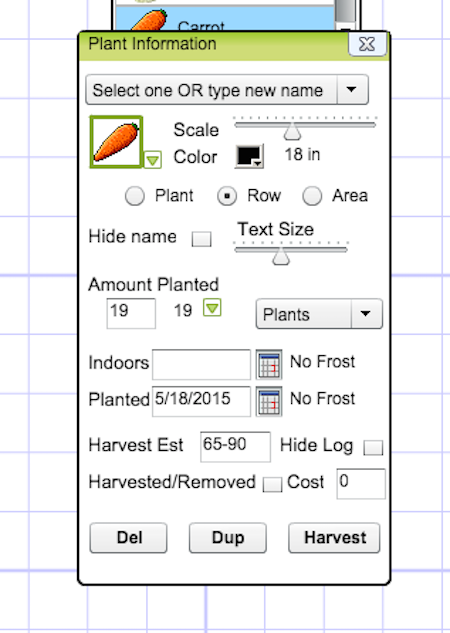
PG also offers a Daily Log function, which is basically a gardening journal, that lets you note when you compost, fertilize, work in your greenhouse, whatever, which you can export to Excel/Numbers.

As far as the printing of the actual garden design, PG does a nice, albeit utilitarian job.

Mother Earth News Garden Planner
Third on our list is Mother Earth News Garden Planner (MEN for short). You can snag this for $25 a year or $40 for 2 years (and a 30 day free trial). This is only available as an online version and requires Adobe Flash version 9+. Again, we don’t have to give our credit card details to play with the trial version. This time, we are emailed an activation code to get started, but that’s no biggie.
Like PG, MEN asks for a zip code but not just to recommend plants for my part of the world, but to keep track of frost dates.
To start your garden design, simply choose the size of your garden, in this case another ample 15’ x 30’, and start planning.

MEN is kind of like the best of SBP and PG when it comes to vegetable garden planning. Not only do they have flowers and vegetables, they have structures galore to choose from, including things like fences, trellises, beehives, and even chicken coops. With such a selection, we could be planning entire farming operations. (Kidding, sort of.) They also have an Irrigation selection which includes everything to do with water, like ponds, pumps, and tubes.
Just a small sample of things you can choose to put into your garden:

To keep everything straight, MEN uses a layers function, which are split into 5 categories including Structures (like those chicken coops I mentioned), Plants, Text, Irrigation, and Layout (paths and raised beds and the like). That way you can focus on one aspect of your garden at a time and not get too overwhelmed.
The Structures layer:

When populating your veg garden, MEN really does most of the work. Simply click the plant (in alphabetical order) you want from the database at the top of the page, plop it into your garden, and drag it to the space you want to occupy. So, for instance, if you want 3 rows of corn, simply left click and drag to size. Changing your mind later couldn’t be easier, as another pick and drag magically changes your 6 potato plants to 9 or 12 or 3.
Changing the corn section:

When you left click on the selection just made (corn in this case), another widow pops up that lets you choose a variety (of corn in this case). It also reveals notes concerning your crop and the position of the corn you sowed.

Not sure how to grow all the stuff with which you populated your veg garden? Not to worry, the icons on the MEN database includes a little “i” next to them. Simply click it and up pops everything you need to know to grow one/many of them, including soil requirements, position, feeding, spacing … everything.

As far as summaries and printing goes, MEN will produce a Parts List (accessible via a tab at the top of the page) for the hard stuff, like how many feet of fencing you need to enclose your garden.

MEN also has a kinda magical Plant List that tells you HOW MANY PLANTS YOU ACTUALLY NEED to fill the space as you indicated on your plan. That’s because MEN knows what spacing requirements each plant requires.
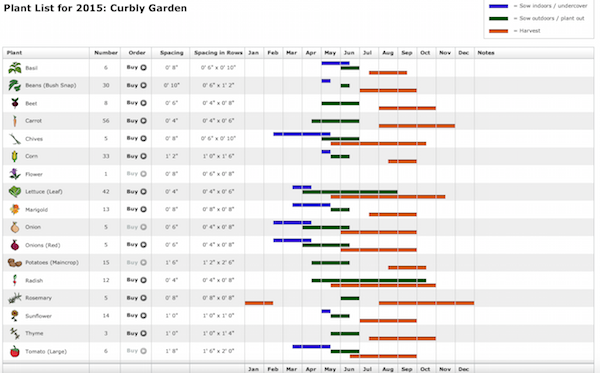
Included on the Plant List is also a color coded chart that tells you when each plant should be sown indoors (if that’s your plan) or outdoors, and tells you when it should be harvested.
As far as printing out your plan, MEN does it perfectly. It’s big, colorful, labeled, and readable.

Finally, we’re going to explore Better Homes and Garden’s Garden Planner (BHG). It’s FREE! But, wait. You have to become a member of BHG to gain access to it. But, wait. You don’t get access to all its features with the free version, which is really just a trial version. Oh, and it’ll cost you $9.99 for six months to access the all its features if you decide you want them. (They don’t tell you any of this until AFTER you sign up.) But, wait. There’s an even more comprehensive version called GardenPuzzle that’s a pay-once desktop version that costs $19 for one license (meaning one user), or $29 for 2 users, or $39 for 3 to 4 users, or $49 for 5 to 10 users. Does it feel like they want you to buy something?
But, be that as it may, let’s get back to the free version. BHG supplies the backgrounds; it’ll cost you that $9.99 to upload a background/photo of your own, which, again, they don’t tell you before you sign up for the free version.
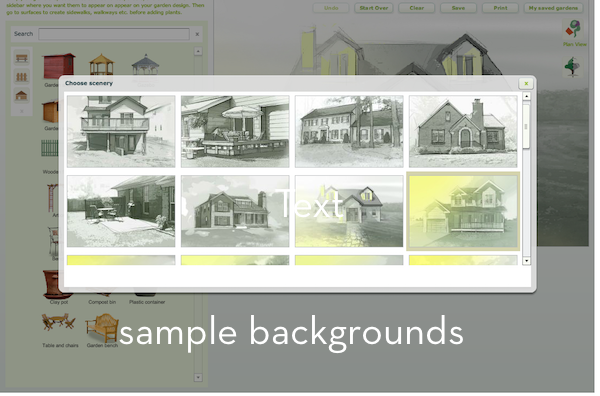
Backgrounds are architect heavy, so right away you can tell this is a planner that is NOT suited for vegetable gardens. And, although they do have a ‘raised beds’ choice, there is no way to fill them. So, yeah, not for planning a garden.
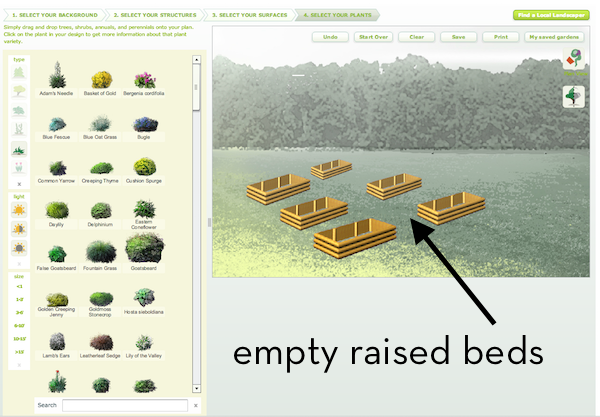
Of all the planners on our list, BHG is the easiest to maneuver, but that’s because it doesn’t allow for much customization. Basically, you pick your background, select your structures (like those raised garden beds, or sheds, benches, pots, etc., which you pick and plop), choose your surfaces (lawn, mulch, brick, etc. which you pick and draw), and plants, (trees, bushes, vines, etc., which you pick and plop).

BHG operates on depth of field, so when you plop your items, they’ll be bigger in the foreground than in the background of your plan.

They’re easily adjustable, though, with a rudimentary + or – that appears in a popup when you click on the object in the plan that you want to resize. Also in that window, we get another little ‘i’ for information regarding the object. Click it and another window will pop up with access to ‘more.’ Click that and you’ll be shunted to BHG’s Plant Encyclopedia.
We need to mention the two small icons on the right of the plan page. One is called ‘Plan View’ and it gives you an aerial view of the plan you just made sans structure. The view is so small it is rendered useless. The other icon doesn’t have a name, but if you click it, you can apply paint effects to your plan.

Various paint effects:

Why apply paint effects to your plan? I have no idea, but it is kinda fun.
Finally, BHG does allow you to save your garden plan and print it, which it does nicely.
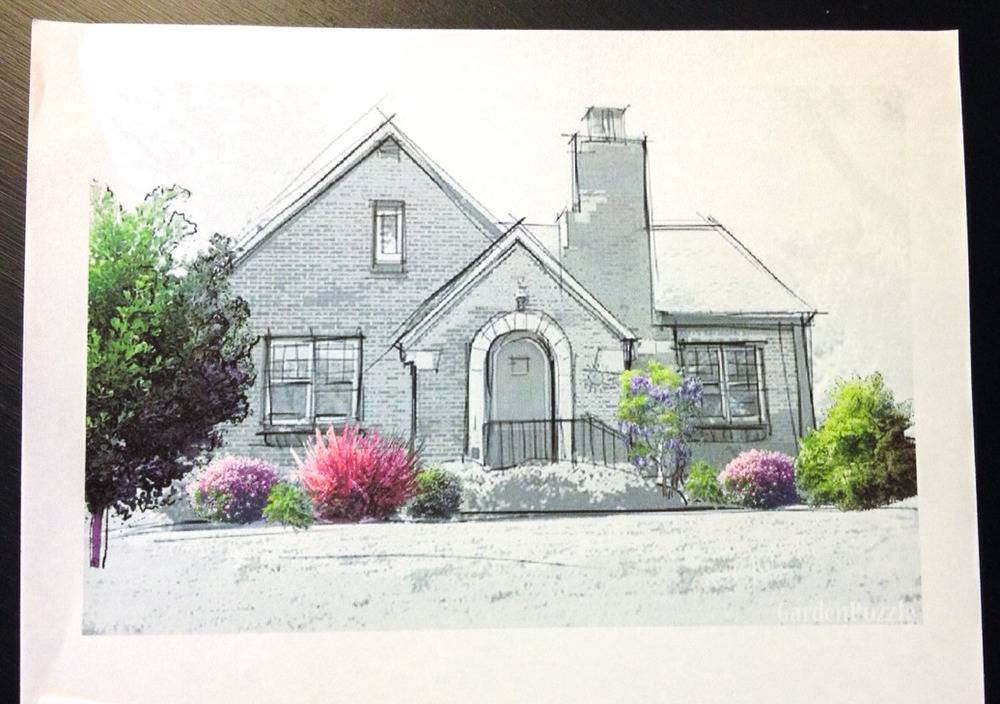
Now the Grades!
Small Blue Printer – B+
It’s packed with objects in which to fill your dream garden. It’s NOT for vegetable garden planning whatsoever. But if you’ve got dreams of a creating a beautiful yard, this might be the planner for you. And, because it’s a one time download, it is cost effective. Keep in mind, however, there is no 3D depth of field option here, so you’ll have to use your imagination when considering elevations and such, because when it comes to general yard landscaping an elevation view can be very important. In all, I’ll give Small Blue Printer a solid B+ for general landscape planning (it would have gotten an A if it had an elevation view), but for vegetable garden planning, I’m afraid it gets a D. HOWEVER, as a free on-line garden planner, it gets an A.
Plan Garden – C
No frills, but super easy to navigate. Of the subscription services, this is the cheapest and, at 45 days, it has the longest trial period. If not going up against Mother Earth News Garden Planner, I’d give it a B, but because it IS going up against MEN, I’ll give it a C.
Mother Earth News Garden Planner – A
It should come as no surprise to those who’ve read this entire post that this planner is our best performer. For vegetable garden planning, it’s unparalleled. Yes, at $25 a year, it’s the most expensive of the subscription services, but I could see the price being made up for in crop loss and all around aggravation-savings. It’s packed with objects and plants to populate your garden, as well as information that would turn any brown thumb green. No, there isn’t an elevation feature, but with vegetable gardens, flat is good—unless we’re talking elevated beds, which are still flat. So, even without that feature, I give MEN an A versus SBP which came in with a B+ because of the importance of the elevation feature when it comes to general yard landscaping.
Better Homes and Gardens Garden’s Garden Planner – B for fun (D for practicality)
Again, this was a run-through for the FREE version from BHG. I can’t comment on the GardenPuzzle version. That said, I see this version as being good for brainstorming but not for serious landscape planning. So, for fun, I’ll give it a B, but for practicality, it gets a D.
And there you have it, my review of 4 popular garden planners. Now go forth and plant, my children.
FINAL NOTE:
None of the people/creators of these garden planners supplied products for this review. As for the opinions of the products, those are mine and mine alone. If anyone has any further questions about the individual products reviewed, I’ll do my best to answer them for you. Just ask in the comments below.

Hello,
Thank you for this great review. My hubby was already getting suggested planting guide by e-mails from Mother Earth News and although we like it and found it useful we were wondering whether it was worth getting the subscription. After reading your review we have made our minds up and will be registering with fully because it is exactly what we were looking for. Thank you again for trying it out for us
best regards
Marie Pierre
@Marie Pierre–You are very welcome!
Thank You for the review. This is exactly what I was looking for.
Does the MEN garden planner allow you to save and print multiple designs for different yards?
@ Eliza–Yes, you can save and print up to 5 plans at one time, but only if you sign up for the subscription service. (The free trial only allows you to save/print 1 garden plan at a time.)
Thank you for the work you put into doing your review of these garden planners.
I tried Mother Earth’s Planner (free trial) and was pretty pleased with it and your review sealed the deal for me. I will be subscribing to MEN.
Thanks again,
Christi
Have been using MEN planner for three years and the limitations have me looking for other options. For example. We are farming an odd shaped 1200 feet by 110 foot area that effectively gives us close to two acres but the planner cannot print these dimensions effectively. Eben on five sheets of 11 by 14. The alternative is to create four or five separate garden areas however that loses the planner effectiveness in crop rotation seeing as the multiple plans cannot be integrated. Any suggestions?
Sorry to disagree, but I have been extremely disappointed by the MEN Planner. It does all that you mention, and better than others, but try investing YEARS of effort in design and plant research on successive gardens and then trying to print out a large garden -or- its “Plant List” that contains your precious notes. The Flash design of this program will reliably mess this up. Moreover, I’ve written the TS about these issues and didn’t even receive the courtesy of a reply. So if you want to invest as much time on the PC as you do in your garden and trust that being a loyal customer will be rewarded..keep looking.
Thank for the useful information!